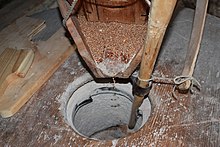Lesachtaler bread production
The Lesachtaler bread making describes the traditional bread making in the Austrian Lesachtal especially in the places Maria Luggau and Liesing .
It includes the cultivation of grain , the extraction of the grain in a mountain farming region and the necessary knowledge for building mills, special dialect expressions, rituals as well as the annual mill festival in Maria Luggau and the Lesachtal village and bread festival.
Traditional knowledge
Bread-making in the Lesach Valley is a traditional craft technique. This includes the cultivation of grain and the harvest, as well as the grinding of the grain and the baking of the bread in the Lesach Valley villages of Maria Luggau and Liesing in the federal state of Carinthia . The traditional craft not only includes the art of baking, it is particularly characterized by the special vocabulary and rituals , such as drawing three crosses before cutting or putting a palm cross in the field. This type of pasta production is a symbol of tradition and regionality . This is celebrated annually by the village, mill and bread festival.
Bread baking rituals
There are over 100 different bread recipes in the Lesach Valley. Traditionally, the bread is baked by women who pass on their recipes to their daughters-in-law. The dough is prepared the evening before, when a cross is drawn in the pre-dough. Before baking, an IHS stamp ( bread stamp ) is pressed into each loaf of bread and finally three crosses are carved into the crust of the finished bread as a ritual of gratitude.
Dialect expressions
Dialect terms from the Lesachtal for facilities and equipment for bread baking:
- Khrongrånt ( Korngrant )
- Påchgrutte ( Backgrutte )
- Taagschaufl ( dough scoop )
- Muäsa ( muser )
- Schååwa ( scraper )
- Proatflekke ( bread board)
- Khrukhe ( bread towel )
- Proatruume (broach frame)
- Proatgråmbl ( bread slicer )
Customs care
Festivals and tourism
In 2010 the Lesach Valley tradition of baking bread using traditional methods was added to the UNESCO list of intangible cultural heritage . Two well-attended festivals underline the importance of this culinary tradition and combine it with music and song. The annual mill festival in August in Maria Luggau and the Lesachtal village and bread festival on the first weekend in September in Liesing are very popular.
societies
The association "Bread for Life" was founded in 2008 under chairman Werner Lexer in the Lesachtal Lesachtal . The aim of the association is the elimination of famine and support for self-help for food cultivation and production, as well as for training measures in underdeveloped countries.
International reception
After the Japanese ethnologist Eiko Funada published about the Carinthian tradition, a local timber entrepreneur decided to replicate the Austrian bread-baking huts true to the original. Since then, Lesachtaler bread has also been baked according to the traditional farmer's style in the Japanese capital Tokyo .
literature
- Eiko Funada: bread. Part of life. With house recipes from the Lesach Valley. Mitteldeutscher Verlag, Halle (Saale) 2009, ISBN 978-3-89812-609-0 , pp. 60ff.
Web links
- Entry in the register of intangible cultural heritage of UNESCO
Individual evidence
- ↑ UNESCO
- ↑ UNESCO, Intangible Cultural Heritage
- ^ Doris Wegner: Snack. In: Augsburger Allgemeine : Reise-Journal. Issue No. 79, April 3, 2012, p. 19.
- ↑ Eiko Funada: bread. Part of life. Mitteldeutscher Verlag, Halle (Saale) 2009, ISBN 978-3-89812-609-0 , p. 60 ff.
- ↑ Bread for Life Association, accessed on May 5, 2017
- ^ Doris Wegner: Snack. In: Augsburger Allgemeine: Reise-Journal. Issue No. 79, April 3, 2012, p. 19.





